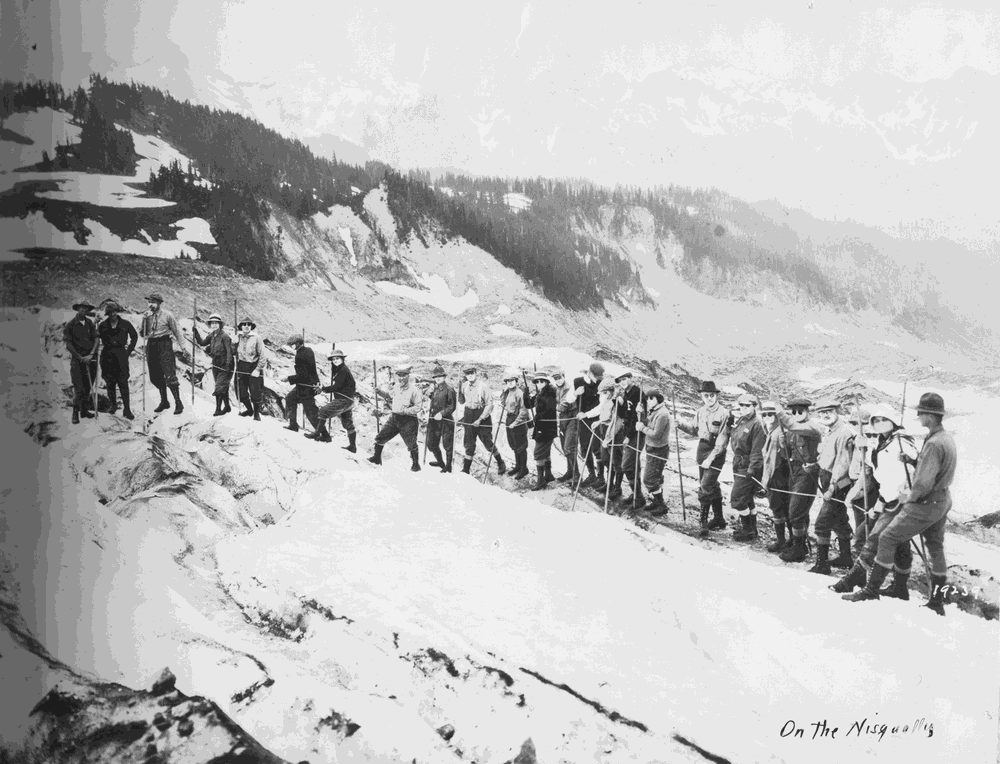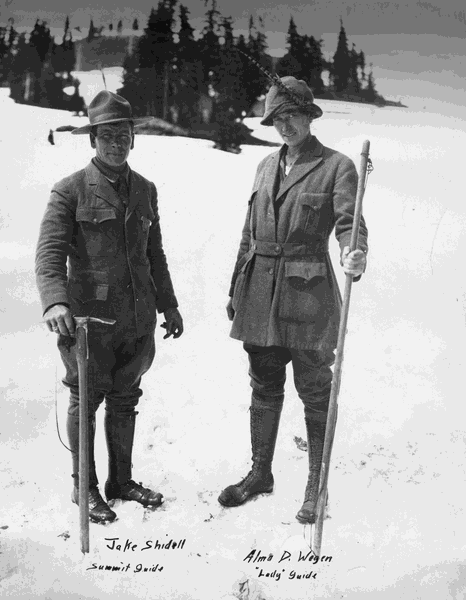
In 1918, Alma Wagen, an early member of The Mountaineers, was declared the first woman to join Mount Rainier’s guide staff. Upon accepting this position, Alma knew her accomplishment was not just personally life-changing, but also an opportunity to bring other women into climbing. “At last I had found the time and the place to climb, and I climbed hills and mountains and learned everything I possibly could about climbing,” she told a journalist in a 1923 interview for American Magazine. “Then I looked for new fields to conquer and found my life's work. I wanted to teach other women the joy of climbing.”
Destined for climbing
Born in Minnesota in 1878, Alma grew up on her grandparents’ wheat farm. As a young girl, she had an irresistible desire to scramble up the wire frames of the windmills on their property and look out across the rolling plains. “I wanted to get up among the clouds and to feel myself free as the birds and the air,” Alma recounted. “To be able to shout my freedom as loudly as I liked without having someone point to me sadly and say, ‘It is not pretty for little girls to climb windmills.’”
In search of higher peaks, Alma moved to Washington as soon as she graduated from college. She started her career teaching high school math in Tacoma, where she developed a reputation as a relentless grader among her students. On clear days, she would gaze out her classroom window to admire Mount Rainier.
Arguably the best part of her teaching position was that she had summer breaks to explore the mountain ranges of the Pacific Northwest. Without any official wilderness navigation training, she went route-finding in the Olympic Mountains. She adventured with purpose through these scattered subalpine forests and broad valleys, with the Pacific Ocean shimmering in the distance. The following year, she hiked, climbed, and explored alone in the Alaskan backcountry. On these self-directed excursions, she experimented with various roped climbing techniques, relied on her wooden alpenstock while crossing snowfields, and logged pages of trip information in her journal. After a transformative summer in Glacier National Park, she set her sights on becoming a mountain guide for the National Parks Service.
Testing her mettle
In 1913, Alma joined The Mountaineers to gain the skills required to summit more technical peaks. In 1915, she put her new skills into practice on a Mountaineers outing around Mount Rainier. After completing a 100-mile backpack around the base of the volcano, their trip culminated in a climb to the summit from the north side, a route that wasn’t well-documented until the thirties. When asked about that challenging climb, Alma said “By that time, I felt that I could climb any mountain that ever reared its head in the air.”
Her efforts just two summers later proved her determination. In 1917, Alma participated in the 11th annual summer outing of The Mountaineers. The itinerary, as Alma described in the 1917 Mountaineer annual, was a 240-mile trek in the heart of the North Cascades, marching up “the zig-zag trails, over snow slopes, under the glaring sun.” It was her most ambitious trip to date. The adventurous party not only scaled Mount St. Helens, but they continued on foot to Mount Adams and Mount Hood, summiting both of these peaks as well.
JAKE SHIDELL, SUMMIT GUIDE, AND ALMA WEGEN, "LADY" GUIDE, ON MOUNT RAINIER, WASHINGTON, 1919, COURTESY OF UNIVERSITY OF WASHINGTON LIBRARIES, SPECIAL COLLECTIONS, UW 14003.
Alma recalled reaching the snow-capped peak of Mount Hood, eliciting a feeling like no other. “No one but a mountain climber can know the joy it brings to reach the top at last, and to realize that you are alone with the fresh, free air, while you rest and enjoy the view and plan for other peaks to conquer.”
Holding her place on Mount Rainier
Even after ticking off many routes across Washington and beyond, Alma’s greatest joy was playing on the slopes of Mount Rainier National Park. She dedicated hours to studying Rainier’s glaciers and crevasses, and to mastering the botany and geological features that characterized the park.
Alma finally applied to be a mountain guide at Mount Rainier National Park in 1918, at the tail end of the First World War. Many positions dominated by men were left vacant by the draft, and the park service was forced to acknowledge the capacity of women to step into these roles. Rainier’s Guide Manager Joe Hazard could not dismiss Alma’s technical expertise and understanding of the mountain. “Miss Wagen is capable, resourceful, has nerve, judgement, discretion,” he told Sunset Magazine. “Forget that she is a young woman, highly educated with a most charming personality. Miss Wagen is holding her place on Mount Rainier for the reasons that she is a superlatively good guide. No more is to be said.”
That same year, Paradise Inn opened its doors. Alma began bringing guests up to Pinnacle Peak, to stroll along the Nisqually and Paradise Glaciers, and to visit Camp Muir. She led hikes on the Emmons Glacier, located on the northeast flank of Mount Rainier which she had climbed on her first summit with The Mountaineers. Alma was respected as a highly-capable guide, even entrusted to guide financier John D. Rockefeller Jr.’s party to Rainier’s summit in 1920.
On top of the world
In many ways, Alma paved the road for those who came after her, exploring the mountains and waters of the Pacific Northwest despite the doubts of others. It may not have been “pretty” for a woman to climb, but it was what she lived for. “Up on top of the world, one learns what people really are,” Alma once said. “There is no better fun in the world to know the wonderful exhilaration of viewing range on range of mountain peaks that rise in tinted ranks above the sky.”
Lead image of hikers on Nisqually Glacier, led by Fairman B. Lee and Alma Wagen, 1919. Photo by Frank A. Jacobs, courtesy of University of Washington Libraries, Special Collections, UW 41469.
This article originally appeared in our summer 2022 issue of Mountaineer magazine. To view the original article in magazine form and read more stories from our publication, visit our magazine archive.
 Issy Steckel
Issy Steckel
